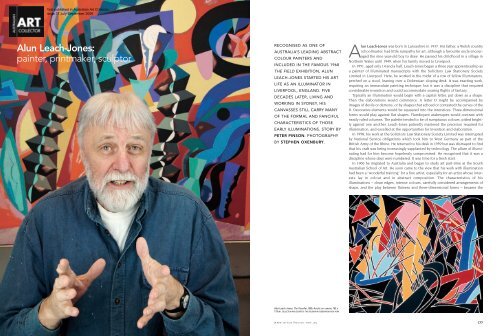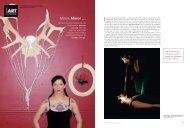Alun Leach-Jones: painter, printmaker, sculptor - Australian Art ...
Alun Leach-Jones: painter, printmaker, sculptor - Australian Art ...
Alun Leach-Jones: painter, printmaker, sculptor - Australian Art ...
Create successful ePaper yourself
Turn your PDF publications into a flip-book with our unique Google optimized e-Paper software.
<strong>Alun</strong> <strong>Leach</strong>-<strong>Jones</strong>:<br />
<strong>painter</strong>, <strong>printmaker</strong>, <strong>sculptor</strong><br />
176<br />
First published in <strong>Australian</strong> <strong>Art</strong> Collector,<br />
Issue 37 July-September 2006<br />
RECOGNISED AS ONE OF<br />
AUSTRALIA’S LEADING ABSTRACT<br />
COLOUR PAINTERS AND<br />
INCLUDED IN THE FAMOUS 1968<br />
THE FIELD EXHIBITION, ALUN<br />
LEACH-JONES STARTED HIS ART<br />
LIFE AS AN ILLUMINATOR IN<br />
LIVERPOOL, ENGLAND. FIVE<br />
DECADES LATER, LIVING AND<br />
WORKING IN SYDNEY, HIS<br />
CANVASSES STILL CARRY MANY<br />
OF THE FORMAL AND FANCIFUL<br />
CHARACTERISTICS OF THOSE<br />
EARLY ILLUMINATIONS. STORY BY<br />
PETER PINSON. PHOTOGRAPHY<br />
BY STEPHEN OXENBURY.<br />
<strong>Alun</strong> <strong>Leach</strong>-<strong>Jones</strong>, The Traveller, 1985. Acrylic on canvas, 152 x<br />
173cm. COLLECTION AND COURTESY: THE SOLOMON R GUGGENHEIM, NEW YORK.<br />
<strong>Alun</strong> <strong>Leach</strong>-<strong>Jones</strong> was born in Lancashire in 1937. His father, a Welsh country<br />
schoolmaster, had little sympathy for art, although a favourite uncle encouraged<br />
the nine year-old boy to draw. He passed his childhood in a village in<br />
Northern Wales until 1949, when his family moved to Liverpool.<br />
In 1951, aged only 14 and a half, <strong>Leach</strong>-<strong>Jones</strong> began a three year apprenticeship as<br />
a <strong>painter</strong> of illuminated manuscripts with the Solicitors Law Stationery Society<br />
Limited in Liverpool. Here, he worked in the midst of a row of fellow illuminators,<br />
perched on a stool, leaning over a Dickensian sloping desk. It was exacting work,<br />
requiring an immaculate painting technique, but it was a discipline that required<br />
considerable invention and could accommodate soaring flights of fantasy.<br />
Typically an illumination would begin with a capital letter, put down as a shape.<br />
Then the elaborations would commence. A letter D might be accompanied by<br />
images of devils or demons, or by shapes that echoed or contested the curves of the<br />
D. Decorative elements would be squeezed into the interstices. Three-dimensional<br />
forms would play against flat shapes. Flamboyant arabesques would contrast with<br />
neatly ruled columns. The palette tended to be of sumptuous colours, pitted brightly<br />
against one another. <strong>Leach</strong>-<strong>Jones</strong> patiently mastered the precision required for<br />
illumination, and excelled at the opportunities for invention and elaboration.<br />
In 1958, his work at the Solicitors Law Stationery Society Limited was interrupted<br />
by National Service obligations which took him to West Germany as part of the<br />
British Army of the Rhine. He returned to his desk in 1959 but was dismayed to find<br />
that his craft was being increasingly supplanted by technology. The allure of illuminating<br />
had for him become hopelessly compromised. He recognised that it was a<br />
discipline whose days were numbered. It was time for a fresh start.<br />
In 1960 he migrated to Australia and began to study art part-time at the South<br />
<strong>Australian</strong> School of <strong>Art</strong>. He soon came to the view that his work with illumination<br />
had been a “wonderful training” for a fine artist, especially for an artist whose interests<br />
lay in colour and in abstract composition. The characteristics of his<br />
illuminations – clean edges, intense colours, carefully considered arrangements of<br />
shape, and the play between flatness and three-dimensional forms – became the<br />
www.artcollector.net.au 177
178<br />
First published in <strong>Australian</strong> <strong>Art</strong> Collector,<br />
Issue 37 July-September 2006<br />
<strong>Leach</strong>-<strong>Jones</strong> patiently mastered the precision required for illumination, and excelled at the<br />
opportunities for invention and elaboration.<br />
www.artcollector.net.au<br />
characteristics of his paintings.<br />
By the mid 1960s, aged about 30, he was working on his Noumenon series which<br />
swiftly established and sealed his reputation as one of Australia’s leading abstract<br />
colour <strong>painter</strong>s. He participated in The Field exhibition which opened the newly built<br />
National Gallery of Victoria in 1968. This exhibition, which included the work of<br />
Sydney Ball, Col Jordan, David Aspen and Peter Booth, focused on those artists<br />
who had emerged over the previous few years with work that was precisely calculated,<br />
abstract, and overwhelmingly concerned with flat, aggressive colour<br />
relationships. These were the characteristics that would underpin and nourish<br />
<strong>Leach</strong>-<strong>Jones</strong>’s work for the next four decades.<br />
<strong>Leach</strong>-<strong>Jones</strong> also established a formidable reputation as a <strong>printmaker</strong>, working<br />
with master <strong>printmaker</strong>s including Larry Rawling, Diana Davidson and Michelle<br />
Perry. Silk screen printing was the perfect medium for dealing with his interest in flat<br />
areas of colour, but he has also worked in lithography, etching and lino cuts. He has<br />
completed well in excess of 150 editions of prints in his career. One of his notable<br />
silk screen prints employed 73 different colours, which was considered to be a world<br />
record for a silk screen print by a major artist.<br />
While <strong>Leach</strong>-<strong>Jones</strong> is best known for his paintings, drawings and prints, he has<br />
also been making small bronze sculptures over the last 18 years. In the early 1970s,<br />
prominent Melbourne <strong>sculptor</strong> Lenton Parr had foreseen how well <strong>Leach</strong>-<strong>Jones</strong>’s<br />
capacity to invent and arrange shapes could be expressed in sculpture, but at that<br />
time <strong>Leach</strong>-<strong>Jones</strong> was unconvinced. Years later, in 1988, Robert Klippel visited<br />
<strong>Leach</strong>-<strong>Jones</strong>’s studio. He noticed a small three-dimensional arrangement made from<br />
thin sheets of balsa wood. <strong>Leach</strong>-<strong>Jones</strong> had constructed it to explore and clarify<br />
some compositional issues he was contending with in a painting.<br />
“Let me have a cast of this made,” Klippel requested. <strong>Leach</strong>-<strong>Jones</strong> dubiously consented.<br />
When Klippel returned with the balsa cast in bronze, <strong>Leach</strong>-<strong>Jones</strong> was<br />
astonished. To his surprise, it successfully retained the same skirmishing of contending<br />
shapes that was at the heart of his paintings. Moreover, the abstract<br />
This page: <strong>Alun</strong> <strong>Leach</strong>-<strong>Jones</strong>, The Fountain, 2002. Acrylic on<br />
canvas, 168 x 183cm. COURTESY: THE ARTIST AND HEISER GALLERY, BRISBANE.<br />
Opposite page: <strong>Alun</strong> <strong>Leach</strong>-<strong>Jones</strong>, The Dark Mirror, 2004. Acrylic on<br />
canvas, 123 x 127cm. COURTESY: THE ARTIST AND HEISER GALLERY, BRISBANE.<br />
www.artcollector.net.au 179
180<br />
First published in <strong>Australian</strong> <strong>Art</strong> Collector,<br />
Issue 37 July-September 2006<br />
“Let me have a cast of this made,” Klippel requested. <strong>Leach</strong>-<strong>Jones</strong> dubiously consented.<br />
When Klippel returned with the balsa cast in bronze, <strong>Leach</strong>-<strong>Jones</strong> was astonished.<br />
www.artcollector.net.au<br />
arrangements unfurled unpredictably as one walked around the piece, like the<br />
unravelling narrative of some picaresque novel. Lenton Parr had been right.<br />
Unlike Klippel, whose assemblages were made from components that had been<br />
found or acquired, <strong>Leach</strong>-<strong>Jones</strong> has pieces of timber cut and shaped to his precise<br />
instructions, and he then sets about positioning them together with the same fastidious<br />
precision he employs in his paintings. There is nothing two-dimensional or<br />
bas-relief-like about these sculptures; they are not “<strong>painter</strong>’s sculptures”. They are<br />
domestic in size – typically only about 35 cms high – yet they possess a sense of<br />
scale; there is something epic about them.<br />
<strong>Alun</strong> <strong>Leach</strong>-<strong>Jones</strong>’s work may be viewed in all the State Galleries, which have collected<br />
many of his largest paintings. He is represented by Rex Irwin <strong>Art</strong> Dealer in<br />
Sydney, by BMGART in Adelaide, and by the Bruce Heiser Gallery in Brisbane.<br />
Although he has commanded a firm following among private collectors since the<br />
mid-1960s, his paintings appear at auctions only infrequently. <strong>Leach</strong>-<strong>Jones</strong> is himself<br />
at a loss to explain this phenomenon (other than taking the obvious and<br />
flattering inference that owners are reluctant to trade away his work). Collectors<br />
wishing to acquire one of his works at auction would need to be particularly patient.<br />
On the other hand, <strong>Leach</strong>-<strong>Jones</strong>’s paintings are remarkably consistent in quality<br />
(unlike, say, the paintings of Sidney Nolan and Charles Blackman), and a work being<br />
offered in an auction is not likely to be inferior to works available through dealers.<br />
Flawless and immaculate surfaces are an important dimension of <strong>Leach</strong>-<strong>Jones</strong>’s<br />
paintings. Initial purchasers are generally required to contract to return to him any<br />
painting which has sustained damage, to allow him to undertake the restoration. He<br />
would normally undertake such reparation without charge.<br />
<strong>Alun</strong> <strong>Leach</strong>-<strong>Jones</strong> has been the subject of an impressively extensive bibliography.<br />
The major book is the Craftsman House monograph published in 1988, written by<br />
This page: <strong>Alun</strong> <strong>Leach</strong>-<strong>Jones</strong>, Red Skye at Night -<br />
Shepherd’s Delight, 2001. Acrylic on canvas, 122 x 183cm<br />
COURTESY: THE ARTIST AND HEISER GALLERY, BRISBANE.<br />
Opposite page: <strong>Alun</strong> <strong>Leach</strong>-<strong>Jones</strong>, The Golden Bowl,<br />
2003. Acrylic on canvas, 168 x 183cm. COURTESY: THE ARTIST<br />
AND HEISER GALLERY, BRISBANE.<br />
www.artcollector.net.au 181
182<br />
First published in <strong>Australian</strong> <strong>Art</strong> Collector,<br />
Issue 37 July-September 2006<br />
However, <strong>Leach</strong>-<strong>Jones</strong>’s allusions to life’s miseries are more than offset by his glorious colours<br />
which bustle and pulsate with the resounding exaltation of a Chartres window.<br />
www.artcollector.net.au<br />
his poet friend Robert Gray, Graeme Sturgeon (who had been the initial Director of<br />
<strong>Art</strong>bank) and Christopher Gentle (the inaugural Director of Sydney’s Ivan<br />
Dougherty Gallery). This monograph was republished in an expanded edition in<br />
1995. An unusually large number of substantial and detailed catalogues have<br />
accompanied his solo exhibitions, generally with serious and penetrating essays.<br />
His paintings and prints have been the subject of six mid-career Survey exhibitions<br />
in <strong>Australian</strong> institutional galleries, and at the Glynn Vivian <strong>Art</strong> Gallery and Museum<br />
in Swansea, Wales.<br />
<strong>Leach</strong>-<strong>Jones</strong>’s coming exhibition in Brisbane is titled The Plain Sense of Things after<br />
a poem by Wallace Stevens (1878-1955). Stevens was an American poet whose work<br />
<strong>Leach</strong>-<strong>Jones</strong> admires. Something of Stevens’s melancholy is echoed in the sombre<br />
blacks of <strong>Leach</strong>-<strong>Jones</strong>’s paintings, in the passages of claustrophobically compressed<br />
forms, and in the motifs which obliquely hint at their sources: a pair of spectacles on<br />
a surgeon’s operating dish, or an amputation saw, or a labourer’s cripplingly heavy<br />
tool of trade. However, <strong>Leach</strong>-<strong>Jones</strong>’s allusions to life’s miseries are more than offset<br />
by his glorious colours which bustle and pulsate with the resounding exaltation of a<br />
Chartres window.<br />
<strong>Alun</strong> <strong>Leach</strong>-<strong>Jones</strong> owns an extensive collection of volumes of poetry. Geoffrey<br />
Dutton described it as one of the best private collections of books of poetry in<br />
Australia. It is not surprising that he admired the poetry of Wallace Stevens, whose<br />
work has been described as “enigmatic, elegant, intelligent” with “occasionally startling<br />
meditations on order and the imagination, on reality, appearance and art”. After<br />
all, that description applies equally aptly to his own work. Nor is it surprising that he<br />
was delighted when Peter Goldsworthy said, when opening his recent exhibition in<br />
Adelaide: “You’re never more than one poet away from <strong>Alun</strong> <strong>Leach</strong>-<strong>Jones</strong>.” ■<br />
<strong>Alun</strong> <strong>Leach</strong>-<strong>Jones</strong>’s solo exhibition titled The Plain Sense of Things is at the Bruce Heiser<br />
Gallery in Brisbane from 22 August until 16 September, 2006. The largest painting in<br />
the show, 168 x 214cm, is priced at $33,000, and the smallest paintings, 71 x 97cm,<br />
at $10,000.<br />
Rex Irwin <strong>Art</strong> Dealer is exhibiting <strong>Leach</strong>-<strong>Jones</strong>’s recent sculptures at the<br />
Melbourne <strong>Art</strong> Fair which runs from 2 to 6 August, 2006. These domestic-sized<br />
bronze sculptures will be priced at $8,000.<br />
This page: <strong>Alun</strong> <strong>Leach</strong>-<strong>Jones</strong>, A Midsummer Night’s Dream,<br />
2003. Acrylic on Canvas, 168 x 213cm. COURTESY: REX IRWIN ART<br />
DEALER, SYDNEY. PRIVATE COLLECTION.<br />
Opposite page: <strong>Alun</strong> <strong>Leach</strong>-<strong>Jones</strong>, The Country Beyond<br />
the Stars, 2005. Acrylic on canvas, 168 x 183cm.<br />
COURTESY: THE ARTIST AND HEISER GALLERY BRISBANE.<br />
www.artcollector.net.au 183






